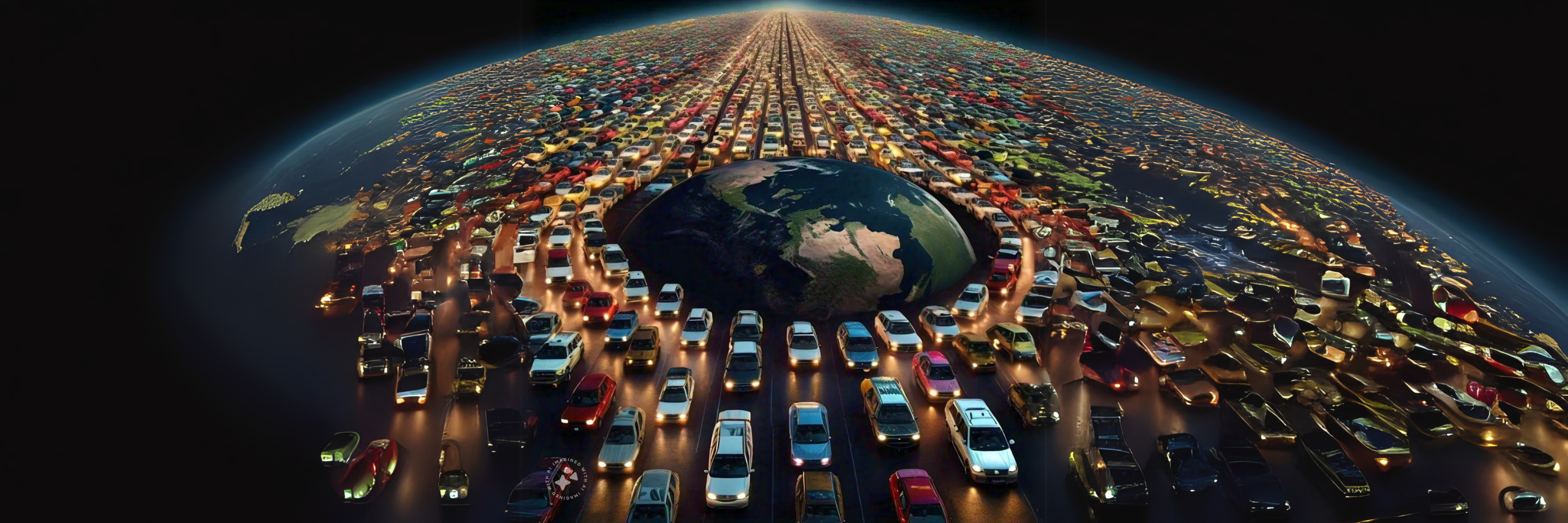- Big Buzz Ideas
- big buzz, big buzz ideas, bigbuzz, bigbuzzideas, earthm, fun fact, Web Development
- 0 Comments
- 1677 Views
Have you ever imagined what would happen if every single car on Earth started driving in the same direction at the exact same time? It may sound like a scene from a futuristic movie, but this thought experiment reveals some fascinating and unexpected consequences. From environmental impacts to physical forces and logistical chaos, let’s dive deeper into this hypothetical scenario and explore what it might mean for our planet and society.
1️⃣ Would the Earth’s Rotation Change?
🔄 The Science of Momentum
To understand if billions of cars could impact Earth’s rotation, let’s explore the concept of angular momentum. Earth is an enormous sphere with a mass of approximately 5.97 × 10²⁴ kilograms, spinning at an incredible speed of 1,674 km/h (at the equator). Compared to this, even the combined mass of all cars in the world is minuscule.
While cars moving together might seem impactful, their weight and momentum relative to Earth are negligible. No matter how fast they drive, the sheer scale of the planet’s rotation would remain unchanged.
💨 The Spin Remains Unchanged
The force required to alter Earth’s rotational momentum would be astronomical, far beyond what billions of cars could achieve. While their synchronized motion could create small, localized effects, the overall spin of the planet would remain unaffected.
2️⃣ Could We Feel the Vibrations?
🌋 Localized Tremors
If billions of cars suddenly started moving in unison, the vibrations caused by engines, tires, and roads would likely create seismic-like effects in localized areas. Urban regions, with dense infrastructure and interconnected road networks, could experience mild tremors. Bridges and highways might face unusual stress, especially if they weren’t designed to handle synchronized vibrations.
💥 Urban Areas at Risk
Although these vibrations wouldn’t compare to the power of natural earthquakes, they could still strain infrastructure. Older buildings and poorly constructed roads could suffer damage, while newly built structures designed to withstand seismic activity might remain unaffected.
3️⃣ What About the Environment?
🌫️ Pollution Surge
The simultaneous operation of billions of cars would result in an enormous release of greenhouse gases like carbon dioxide (CO₂). Even with a growing number of electric vehicles, the majority of cars still rely on fossil fuels. A global surge in car emissions could worsen air quality dramatically, leading to respiratory problems and exacerbating climate change.
The sheer volume of exhaust gases emitted in such a short period could cause localized smog and air pollution, particularly in high-density areas.
🔥 Heat Generation
Beyond air pollution, the heat generated by billions of engines and the friction of tires on roads would slightly raise temperatures in concentrated areas. While this localized heating wouldn’t have a long-term impact on global temperatures, it could make cities and urban areas feel noticeably warmer.
4️⃣ Winds and Weather Changes
💨 Turbulence from Motion
Imagine billions of vehicles moving at high speeds in the same direction—this could cause noticeable turbulence in the atmosphere. Localized winds might develop as the movement of air is displaced by the combined force of cars. For instance, in regions with high vehicle density, you could experience powerful gusts or shifting air currents.
However, it’s important to note that Earth’s weather systems are vast and robust. The movement of billions of cars, while significant on a local level, would be too small to create meaningful changes in global weather patterns.
🌪️ No Lasting Climatic Impact
Unlike large-scale natural phenomena like hurricanes or volcanic eruptions, the atmospheric effects of synchronized car movement would be fleeting and highly localized.
5️⃣ Traffic Chaos Worldwide
🚦 Unimaginable Congestion
One of the most immediate consequences of this scenario would be traffic gridlock. Even with today’s road infrastructure, traffic jams in major cities are already a daily challenge. Now, imagine billions of vehicles moving in the same direction across all continents—roads would be completely overwhelmed.
Urban areas and highways would become parking lots, with drivers stuck for hours or even days. Emergency services and essential transportation systems would come to a halt, causing widespread disruption.
⚡ Energy Crisis
To support such a synchronized movement, the global energy demand for fuel and electricity would skyrocket. Refineries and power grids would struggle to meet the sudden demand, leading to shortages. Oil reserves might be depleted faster than expected, and electric vehicle charging stations would face unprecedented strain.
The logistical challenges of coordinating such an event would also be insurmountable. Governments and industries would need to work together on an unimaginable scale to ensure the smooth execution of this hypothetical event.
6️⃣ The Social and Economic Impact
🛑 Interruptions to Daily Life
With every car in motion, public transportation systems, deliveries, and supply chains would grind to a halt. People without vehicles would be stranded, and businesses relying on goods and services transported by road would face delays.
📉 Economic Consequences
The disruption to industries like logistics, retail, and healthcare would have a ripple effect on the global economy. Stock markets could react negatively, and countries dependent on transportation for trade might face significant losses.
7️⃣ Psychological and Behavioral Effects
🧠 Stress and Anxiety
Drivers participating in such a massive synchronized event would likely experience heightened stress. Managing billions of vehicles on congested roads, dealing with accidents, and navigating unfamiliar routes could lead to widespread frustration.
👫 Community Collaboration
On the flip side, the coordination required for such an event could foster a sense of global unity. People might work together to solve logistical challenges and share resources, highlighting the potential for humanity to come together in the face of unprecedented scenarios.
Final Thoughts
While this scenario is purely hypothetical, it offers a unique lens through which to view the interconnected systems of our planet. From the physical forces governing Earth’s rotation to the environmental and societal impacts, the idea of billions of cars moving in unison serves as a thought-provoking exercise in understanding the balance of our world.
🌟 What Can We Learn?
This scenario underscores the importance of sustainable practices, robust infrastructure, and efficient transportation systems. It also highlights how our actions, even on a small scale, contribute to the larger picture.
While it’s unlikely that all cars will ever move in the same direction simultaneously, the thought experiment reminds us of the power of human ingenuity and the challenges we must address to create a better future.
🌐 Join the Conversation
What do you think would happen if this scenario became a reality? Could humanity rise to the challenge, or would chaos prevail? Share your thoughts in the comments below and let’s explore the possibilities together!
✨ Stay Curious, Stay Informed! ✨
Follow us for more mind-bending explorations of science, technology, and the environment.




